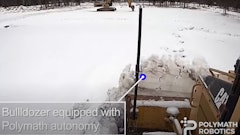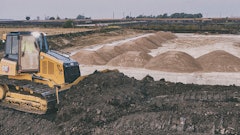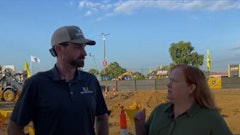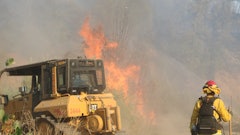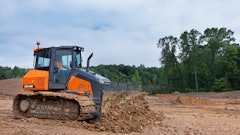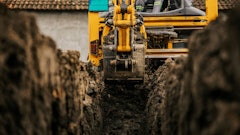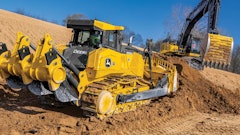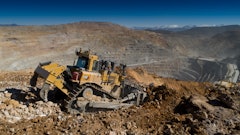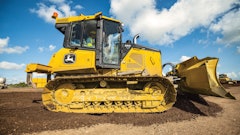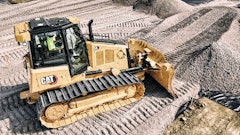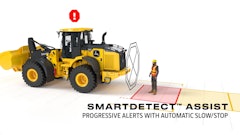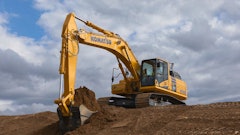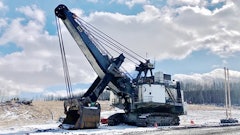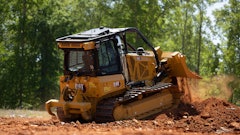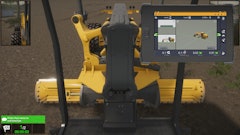
In between the 400--hp pure production dozers and the under 100--hp finish models lies the mid--size dozers. The role of these units continues to evolve with advances in controls and drivetrain technology.
“These dozers have not traditionally been used for fine grading,” says Brett Errthum, John Deere. “But more contractors today are finding they can be used for fine grading.”
This is driving a trend toward extended track models. “Customers are asking for better grading capability,” notes Errthum. “The easiest way for us to do that is to put a longer track on it.”
Speed And Fine Grading Critical
Rodman Excavating, Frisco, TX, relies on mid--size dozers for fine grading. The company owns 45 dozers, including 31 185--hp John Deere 850s, a few John Deere 750s, plus five Caterpillar D8s, four D9s and one D10. “We really don’t have a use for the small fine--grade dozers,” says Les Foster, senior vice president -- operations.
The John Deere 850s are popular with Rodman Excavating due to the hydrostatic transmission, which is unique in this dozer size class. The hydrostatic transmission matches Rodman’s applications — cutting swales and fine grading building pads. “It cuts them very quickly. Then we can fine grade the pad very quickly,” says Foster.
These dozers are equipped with six--way blades and wide shoes for low ground pressure. “We are fine grading a lot of pads and if it is a little wet, we don’t want to sink in,” says Foster.
When confronted with very tight spaces, Rodman Excavating will rent smaller dozers. However, Paul Herron, fleet manager, points out, “Ninety--eight percent of the jobs can be completed just with the John Deere 850.”
Operators have a lot of input into which dozers they run. “They are the ones out there every day. They have to be comfortable and be able to put that machine to use,” says Herron.
A Versatile Solution
Another contractor using medium--size dozers for a variety of applications is Robinson Paving Co., a Georgia--based firm with an equipment fleet numbering over 200 pieces. “We do a fair amount of grading,” says Darrell Robinson, general superintendent. “I have a couple of jobs right now that each have about 900,000 cu. yds.”
Robinson Paving uses four Caterpillar 621 wheel scrapers and eight Noble 417 pull--type scrapers pulled in tandem by 9000 Series John Deere four--wheel--drive and Caterpillar Challenger tractors.
Its dozer fleet is almost entirely Caterpillar D6 machines. “I don’t think this company will ever move away from a Caterpillar D6 because it is such a dependable machine,” says Robinson. “It has just done such a good service for us.” Yet, the company recently purchased a 190--hp Komatsu D65EX extended track model to supplement its fleet.
Due to the nature of its business, the dozers in Robinson’s fleet need to be versatile to handle multiple tasks. The contractor’s current project provides a good example. “On this particular project, we are running four 30--ton Volvo [articulated trucks] in the same grading operation with the Noble pans,” Robinson explains. “A lot of times, we will put the Komatsu D65EX in the fill area to push the piles from the articulated trucks.”
This machine floats around as needed. For example, Robinson has a Caterpillar D6M slope machine with a wide track. Because there is more slope work on the current project than one machine can handle, the D65EX also gets pressed into a little slope work. “It does well there,” says Robinson.
But the primary task of the D65EX has been in the cut.
The material on this project is mostly clay, but it can quickly turn to sand. “You just run into a band of sand. A lot of times this will be a pretty good--sized area,” says Robinson. “With the pull pans, you will not get quite full pulling through the sand.” The D65EX is used to help push the scrapers. “You get good, heaped loads out of it, especially when we are in just a short cut,” he states.
Robinson Paving has been happy with the addition of the D65EX to its fleet. “It is such a versatile machine,” says Robinson. “It is a good size that you can put in heavy work or light work. It is good for finish work, cutting ditches, cutting slopes and pushing. It is just a good all--around machine.”
Comfort is an important issue for Robinson. “I like to hear what an operator says about a machine,” he says. “If they like to run it, they can do a better job.
“The hydrostatic steering system has been so much easier for the operators to run,” he adds. “They are more productive with it. I have a guy on it that has been running dozers all of his life. He likes being on it. The controls are just operator friendly. That can really make a big difference with the production and the quality of the work.”
Robinson is also excited about a Caterpillar D6R purchased in October 2003. This tractor is equipped with the Rotating Bushing Track, which should help in the abrasive sand. “I think that is going to be one of the big benefits for the Caterpillar D6. It could cut your costs way down. You don’t have the downtime, and there are costs of pulling the tracks and sending them in to have pins and bushings turned,” he states.
The Rotating Bushing Track is designed to increase chain life when operating in sandy or abrasive conditions. “With the rotating bushing track, you do not get relative motion between the sprocket and the bushing,” says Kent Lynch, sales engineer for track--type tractors, Caterpillar.
However, as with any track configuration, there are limitations. “It is not recommended in high--impact conditions,” says Lynch. “When you get into conditions that might twist the undercarriage, it is probably not as solid as a standard chain.” Unless it is used in sandy or abrasive environments, you may also be unable to justify the cost premium.
Control Advances
“The biggest change has been toward electrohydraulic or electronic controls for steering and transmission, as well as implement control,” says Ronald Schultz, commercial manager, Caterpillar. “The electrohydraulic/electronic controls currently use smaller movements and less force.
Through on--line interactive adjustment, they can provide varying response rates to meet the needs of different applications or operators.”
While the ability to tailor the “feel” of controls to the individual operator is a relatively simple task on Caterpillar dozers, the company is about to release another leap forward. Lynch claims the dozers will soon be equipped with a small 4x5 screen. “You will have the specific settings on that screen by operator name. You just call up a name, hit a button and the machine will set itself to those preferences,” he explains.
Another emerging technology is the onboard diagnostic panel. “From the smallest Komatsu dozer to the largest, all will feature onboard diagnostics,” says Ed Warner, product manager -- dozers, Komatsu. “No longer does the technician have to come out with a set of gauges or a laptop computer. It’s all done through the onboard diagnostic panel.”
Other benefits to the onboard monitor are the ability to accurately track forward and reverse travel distance for track maintenance and as a supervisor tool, as well as the ability to track and schedule preventive maintenance, such as oil changes.
Operating parameters can also be controlled through the monitor. “If you want to lock out third speed reverse, we can do that,” says Warner.
Some manufacturers are also striving to standardize controls across the entire size range so operators can more easily jump from one machine to the next. For example, Errthum reports that John Deere has standardized controls across its dozer product line.
Komatsu has taken a similar approach with the Palm Command Control System on its dozer line. “Now an operator can get off any of the Komatsu dozers, jump to another model and he is right at home,” says Warner. “There is no change.”
The Correct Choice
All manufacturers stress the importance of comfort when choosing a dozer. “Select the dozer that is going to keep the operator happy,” advises Warner. “Make sure the operator is comfortable and the machine has good ergonomics.
Look at the visibility. Take 180º and note what you can see with the tractor. Look at maintenance. Those items that are going to give you a good cost per hour give you the competitive edge when you are bidding on a job.”
Finally, make sure the tractor is spec’d to provide optimum performance on your particular jobsites. The combination of track lengths, gauges and shoe widths complicate dozer selection. “For a Caterpillar D6R, you are probably talking 15 to 20 different configurations,” says Lynch. “So it gets rather complex. I don’t think customers always know how many options are out there.”
These choices allow an optimum solution for almost any task. “There are so many different applications, the biggest asset any of these companies has is to work with their dealer,” says Lynch. “They are the ones that really understand what goes on in a particular geographic territory and what other customers are doing in similar types of work.”
--------------------------------------------------------------------------------------------------------
Hydrostatic vs. Torque Converter Drive
Dozers under 100 hp typically feature hydrostatic drive. This allows the tractor to maneuver more quickly in finish grading applications. “The hydrostatic transmission is beneficial in a utility application where maneuverability is required,” says Ronald Schultz, Caterpillar. But there is disagreement regarding the efficiency of hydrostatic transmissions in mid--size dozers.
Most mid--size dozers use powershift transmissions with torque converters. “With technology currently available, the best hydrostatic transmission is 5% to 15% less efficient than a powershift transmission with torque converter drive,” claims Schultz. “In cases where dozing performance is of key importance, a mechanical transmission will generate a higher percentage of engine power transmitted to the blade or ripper, given that both machines are well balanced.”
Schultz asserts that powershift transmissions can also tackle finish grading. “A powershift transmission, when backed by a differential steering system, can give the level of maneuverability to larger tractors when finish dozing is a required part of the owner’s needs,” he explains. There is also a trend toward electrohydraulic controls that simplify operation. “All of our machines are moving in that direction.”
Komatsu America also equips its mid--size and larger dozers with powershift transmissions with torque converters. They are coupled with the Komatsu Hydrostatic Steering System for ease of maneuverability, according to Ed Warner. “A torque converter allows you to have that ‘umph’ you need when you initially need to load the blade or if you are digging a stump. You just don’t get that with the hydrostatic transmission,” he claims.
However, Brett Errthum argues that hydrostatic transmissions in the mid--size John Deere dozers are just as efficient as torque converter drives, plus they simplify operation. “In the past, hydrostatic dozers had limitations,” says Errthum.
“We have a long--term relationship with our component supplier to develop pumps and motors specifically for our application. Really, the breakthrough came in better electronic controls that help divert the power to where it is necessary.
We have been able to overcome what has been the traditional downfall of the hydrostatic transmission on a large dozer.”
John Deere dozers use a load--sensing hydrostatic system. “When they sense that a load is bogging the tractor down, they will actually slow down the hydrostatics,” says Errthum. “By slowing it down, you are going to get more pushing power.” There is no need for the operator to shift the transmission to compensate for the load. “With a powershift transmission, you generally have three speeds,” he continues. “We have an infinite range.
It will just vary infinitely to the point that it needs to carry the load through. The operator doesn’t do anything that whole time. All he does is focus on that load in front of the blade, making sure his blade is positioned well as he carries the dirt forward.”







